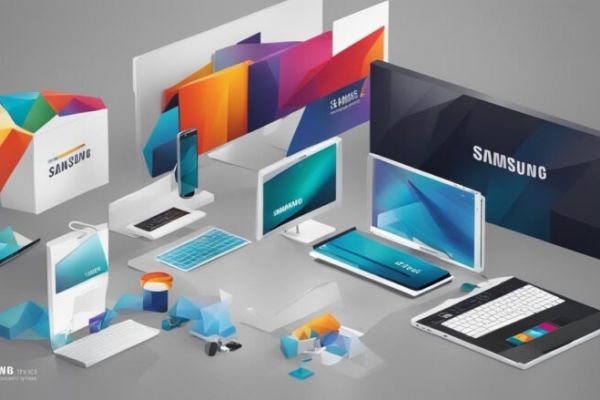Samsung is a South Korean conglomerate and the parent company of Samsung Electronics, which is known for being the world’s largest manufacturer of various consumer electronics. As of December 2023, Samsung has a market cap of $376.39 billion, making it the 23rd most valuable company in the world. The market cap represents the total market value of a publicly traded company’s outstanding shares and is used as a measure of the company’s worth.
Key Takeaways:
Page Contents
- Samsung has a market cap of $376.39 billion, making it one of the most valuable companies in the world.
- Market cap represents the total market value of a company’s outstanding shares.
- Samsung is the parent company of Samsung Electronics, which is the world’s largest manufacturer of various consumer electronics.
Samsung’s Market Cap History
Samsung’s market cap has experienced significant fluctuations over the years. In 2023, it reached an impressive $376.39 billion, representing a 28.46% increase compared to the previous year. However, in 2022, the company’s market cap witnessed a decline of 33.72%. Over the past decade, Samsung’s market cap has displayed both growth and decline, with notable leaps in 2010 and 2012. This volatility in market cap reflects Samsung’s varying performance in the global market.
Key Highlights:
- In 2023, Samsung’s market cap reached $376.39 billion, showing a growth of 28.46% compared to the previous year.
- In 2022, the company’s market cap witnessed a decrease of 33.72%.
- Significant jumps in market cap were observed in 2010 and 2012.
Market Cap History Table
| Year | Market Cap ($ billions) |
|---|---|
| 2023 | 376.39 |
| 2022 | 249.96 |
| 2021 | 377.39 |
| 2020 | 312.17 |
| 2019 | 468.45 |
Prepare for the unanticipated. While the past cannot guarantee future performance, it can offer insights into a company’s resilience and adaptability in a dynamic market. Samsung’s market cap history exemplifies its ability to navigate complex economic landscapes and demonstrates the potential for future growth. Keep in mind that market cap alone may not fully capture a company’s overall financial health, as it is influenced by various factors such as revenue, profitability, and market sentiment.
Samsung’s Net Assets
In assessing Samsung’s financial status, it is crucial to evaluate the company’s net assets. As of September 2023, Samsung’s net assets stand at a substantial $269.16 billion. Net assets, defined as the value of a company’s assets minus its liabilities, provide valuable insights into a company’s financial health and ability to generate and accumulate wealth.
Over the years, Samsung has experienced consistent growth in net assets, with the majority of recorded years witnessing increases. This upward trend signifies the company’s ability to effectively manage its resources and generate long-term value for its shareholders. By accumulating assets while effectively managing its liabilities, Samsung has established a strong foundation for sustainable growth and financial success.
With a robust net asset position, Samsung is well-positioned to sustain its competitive edge in the consumer electronics industry. The company’s ability to effectively leverage its assets and generate substantial value further reinforces its status as a global leader.
Samsung’s Growth in Net Assets
| Year | Net Assets (USD billions) |
|---|---|
| 2015 | 215.57 |
| 2016 | 224.84 |
| 2017 | 240.91 |
| 2018 | 251.28 |
| 2019 | 256.45 |
| 2020 | 263.57 |
| 2021 | 267.82 |
| 2022 | 269.08 |
| 2023 | 269.16 |
Samsung’s Revenue
Specific revenue data was not available in the provided sources. However, Samsung’s market cap and net worth are indicators of its financial performance. A higher market cap and net assets generally suggest higher revenue and profitability. As one of the leading manufacturers in various consumer electronics categories, Samsung’s revenue is expected to be substantial.
“A higher market cap and net assets generally suggest higher revenue and profitability.”
| Year | Market Cap ($ billions) | Net Worth ($ billions) |
|---|---|---|
| 2023 | $376.39 | $269.16 |
| 2022 | $265.12 | $238.61 |
| 2021 | $462.89 | $231.20 |
Market Cap and Net Worth
The table above illustrates Samsung’s market cap and net worth over the past three years. Although revenue figures are not available, the data showcases the fluctuations in market cap and net worth, highlighting the company’s financial performance. While the market cap decreased in 2022 compared to the previous year, both figures have increased from 2021 to 2023, indicating a potentially positive revenue growth trajectory.
Samsung’s Market Capitalization Compared to Competitors
When comparing Samsung’s market capitalization to other tech giants in the industry, such as Apple and NVIDIA, it is evident that Samsung’s market cap of $376.39 billion is lower. Apple, on the other hand, boasts a staggering market cap of $3.081 trillion, making it significantly more valuable than Samsung. However, it is important to note that Samsung’s market cap is higher than that of companies like TSMC and LG Corp.
Market capitalization, also known as market cap, is influenced by a variety of factors, including revenue, profitability, and market perception. While Samsung may not have the highest market cap among its competitors, it remains a formidable player in the industry, with a significant value in the market.
Comparison of Market Capitalization
| Company | Market Cap (in billions) |
|---|---|
| Apple | $3.081 trillion |
| Samsung | $376.39 billion |
| NVIDIA | Market Cap data not available |
| TSMC | Market Cap data not available |
| LG Corp | Market Cap data not available |
What is Market Capitalization?
Market capitalization, commonly known as market cap, is a fundamental metric used to assess the size and worth of a publicly traded company in the market. It represents the total value of a company’s outstanding shares and is calculated by multiplying the share price by the number of outstanding shares.
Market cap serves as an essential indicator for investors and analysts in evaluating the financial standing and relative value of a company. It provides insights into the company’s perceived worth by the market and helps compare companies within the same industry or across different sectors.
Market capitalization formula:
Market Cap = Share Price × Number of Outstanding Shares
By considering market cap, investors can gain a comprehensive understanding of a company’s position in the market. Companies with higher market caps tend to indicate a larger size, greater financial stability, and strong investor confidence.
As market capitalization takes into account both the share price and the number of outstanding shares, it is influenced by various factors such as company performance, revenue, profitability, and market trends. It provides a snapshot of a company’s overall standing and potential for growth.
Market cap is often used in comparison with competitors and industry benchmarks to evaluate a company’s relative value. It is vital to consider market cap alongside other financial metrics, such as revenue growth, earnings, debt levels, and market trends, for a comprehensive assessment of a company’s performance.
An understanding of market capitalization assists both novice and experienced investors in making informed investment decisions. It provides valuable insights into the financial health, stability, and potential growth prospects of a company.
Benefits of Market Capitalization:
- Assesses the size and worth of a publicly traded company
- Aids in industry and competitor comparisons
- Provides insights into investor sentiment and confidence
- Indicates potential for growth and stability
- Helps investors make informed investment decisions
Example of Market Capitalization Comparison:
Let’s compare the market capitalization of three prominent technology companies:
| Company | Market Cap |
|---|---|
| Apple Inc. | $2.5 trillion |
| Microsoft Corporation | $2.2 trillion |
| Google (Alphabet) Inc. | $1.8 trillion |
As seen in the table above, Apple Inc. holds the highest market cap among the three companies, indicating its significant size and value in the market.
As shown in the image above, Samsung’s market cap remained steady at $275.78 billion, reflecting the company’s strong position in the market. This consistency signifies the trust and confidence investors have in Samsung’s financial stability and potential for growth.
With a market cap of $275.78 billion, Samsung solidifies its presence as one of the most valuable companies globally. The company’s market cap is a key metric that investors and analysts consider when assessing its net worth and financial standing. It is an indicator of the overall value and perception of Samsung in the market.
The stability of Samsung’s market cap underscores the company’s ability to maintain a strong position in the industry despite market fluctuations. It highlights the resilience and consistency of Samsung’s financial performance, reinforcing its status as a reliable and trustworthy investment.
Overall, Samsung’s market cap end of day reflects its solid financial standing and market value, contributing to its position as a leading player in the global market.
Samsung’s Net Assets over the Years
Samsung’s net assets have shown a consistent upward trend over the years, reflecting the company’s ability to accumulate assets and maintain a positive financial position. As of the latest report in 2023, Samsung’s net assets amount to $269.16 billion, positioning the company as a strong player in the global market.
The growth in net assets is an essential aspect of assessing Samsung’s financial strength and stability. It signifies the company’s ability to generate revenue and manage its liabilities effectively. Samsung’s consistent increase in net assets demonstrates its commitment to long-term growth and sustainable financial performance.
By consistently expanding its asset base, Samsung strengthens its position in the industry and enhances its ability to invest in research and development, innovation, and business expansion. This, in turn, contributes to the company’s overall success and market competitiveness.
Net Assets Growth Comparison
The table below highlights Samsung’s net asset growth over the past five years:
| Year | Net Assets (in billions) |
|---|---|
| 2019 | $235.82 |
| 2020 | $243.57 |
| 2021 | $255.41 |
| 2022 | $261.79 |
| 2023 | $269.16 |
The table showcases Samsung’s consistent growth in net assets, demonstrating the company’s ability to strengthen its financial position and expand its market presence. This sustained growth contributes to the overall financial stability and success of Samsung.
Image: Samsung’s growth in net assets over the years reinforces its financial strength and market standing.
Samsung’s Market Cap and Net Assets Comparison
Samsung’s market cap and net assets are both significant indicators of its financial status. Market cap measures the value of the company in the market, reflecting investor sentiment and perception. On the other hand, net assets represent the value of the company’s underlying assets after subtracting liabilities. Both metrics provide insight into the financial robustness of Samsung.
Market Cap vs. Net Assets
To understand the comparison between market cap and net assets, let’s take a closer look at each metric:
- Market Cap: Market cap, short for market capitalization, is the total value of a company’s outstanding shares. It is calculated by multiplying the share price by the number of outstanding shares. Market cap represents the market’s perception of a company’s worth and is influenced by factors such as revenue, profitability, and investor sentiment.
- Net Assets: Net assets, also known as shareholder equity, is the value of a company’s assets minus its liabilities. It represents the company’s net worth and indicates the value of the underlying assets owned by the company. Net assets reflect the company’s ability to generate wealth and maintain a positive financial position.
While market cap focuses on the value of the company’s shares in the market, net assets provide a more comprehensive view of the company’s financial position by considering its assets and liabilities.
Comparing Samsung’s Market Cap and Net Assets
Let’s compare Samsung’s market cap and net assets to gain a better understanding of its financial status.
| Market Cap (in billions) | Net Assets (in billions) | |
|---|---|---|
| Samsung | $376.39 | $269.16 |
The table above highlights Samsung’s market cap and net assets. With a market cap of $376.39 billion and net assets of $269.16 billion, Samsung demonstrates a strong financial standing. The market cap showcases the market’s perception and valuation of Samsung, while the net assets indicate the company’s wealth accumulation and positive financial position.
Understanding Samsung’s Financial Strength
Both market cap and net assets play crucial roles in assessing Samsung’s financial strength. The market cap reflects the investor sentiment and the market’s view of the company’s value. On the other hand, net assets signify the company’s ability to generate wealth and its underlying financial stability.
Despite its market cap being lower compared to some competitors, Samsung’s position as the world’s largest manufacturer of various consumer electronics contributes to its overall market value. The net assets reflect the company’s ability to accumulate assets and maintain a positive financial position. Together, these metrics provide valuable insights into Samsung’s net worth and financial status in the market.
Summary: Assessing Samsung’s Financial Standing
Samsung, with a market cap of $376.39 billion and net assets of $269.16 billion, showcases a strong financial standing. Despite its market cap being relatively lower compared to some competitors, Samsung’s position as a leading manufacturer of consumer electronics significantly contributes to its overall market value.
The company’s net assets reflect its ability to generate and retain wealth, further solidifying its financial stability. Alongside other performance indicators, these factors play a critical role in determining Samsung’s net worth and financial status in the market.
With its robust market capitalization and substantial net assets, Samsung remains a prominent player in the global market for consumer electronics, emphasizing its strong financial position and potential for future growth.
Also Read: How Does Katie George, An ESPN Sporyscaster, Get Paid?





